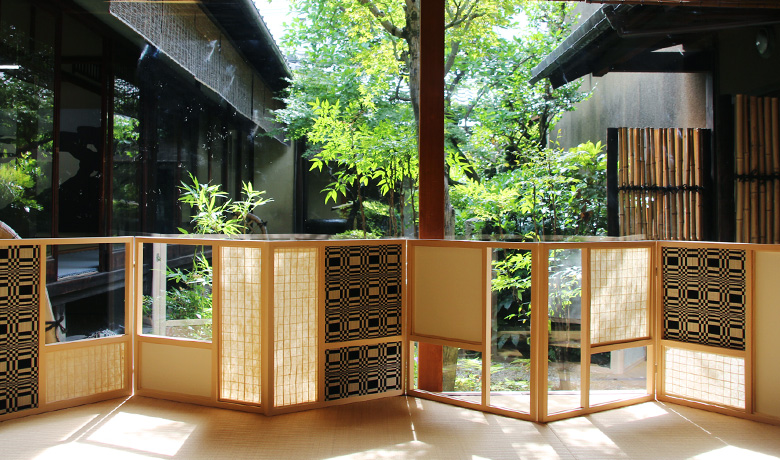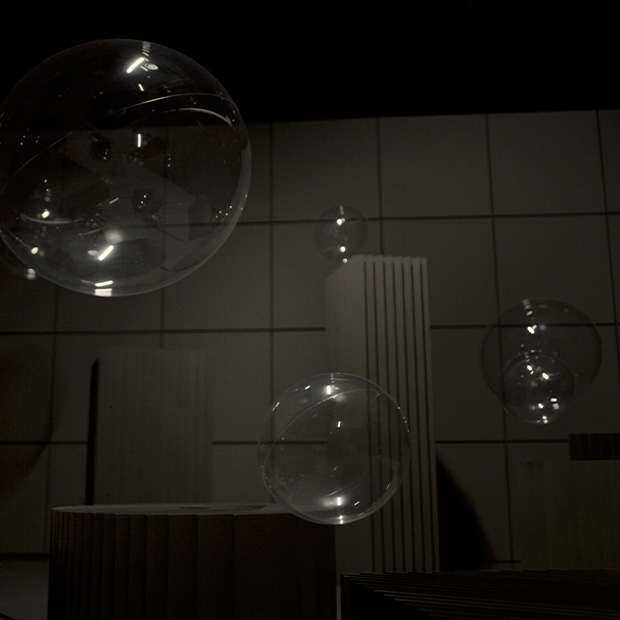Kyoto-based interior design firm Rakusai, which served as the coloring and textile advisor for Daikin residential air conditioner “risora,” joined with Johanna Gullichsen, a prominent Northern European textile brand located in Finland, in a collaboration titled “RAKUSAI collection by JOHANNA GULLICHSEN.” In this interview, Yoshihito Ohta, President of Rakusai, and Kouichirou Seki, Leader of the Advanced Design Group of Daikin, talk about the collaboration.

Koichirou Seki, Advanced Design Group leader (Seki):
This solo exhibition beautifully connected Northern European and Japanese culture. The design fusing Johanna’s geometric patterned textile into Japanese interior is more than just the integration of Japanese and European styles. I felt a sense of nostalgia and originality at the same time, both of which spread throughout every corner of the exhibition venue in an uncannily comfortable manner. Could you tell me what was most important to you in holding this solo exhibition?
Mr. Yoshihito Ohta, RAKUSAI CREATION President (Ohta):
Encounters. The time is coming when the fusion of cultures―a mix-and-match if you will―creates new things. Companies call it collaborative creation, and it will be an era extending all the way to the level of the individual creator. Naturally, I wanted to once again test the possibilities of design by appreciating encounters with people who are obsessed with monozukuri (creating things), establish a bond with them, and mutually refine our own obsessions.

Seki:
In that context, I assume that your encounter with Johanna was of the greatest importance for this exhibition. What brought you to work with Johanna?
Ohta:
Even before this collaboration, I had thought that Finnish and Japanese monozukuri cultures were similar in their pursuit of practicality and beauty in daily household goods. Besides, I wanted to restore an undiluted monozukuri culture in Japan. When that in mind, I met with Johanna, the leading Finnish textile designer. I identified with her thoughts and beliefs on monozukuri, and we hit it off well.

Seki:
I had an opportunity to talk with Johanna, too. When I heard her wish to offer designs that match people’s lives, I felt that there was a common thread shared by resource-scarce countries of “ taking care of things,” which has long existed in both Japanese and Northern European cultures.
Ohta:
As well as taking care of things, her wish also implies enriching things. Design is not just a tool to resolve issues: it also has a mission to enrich people’s hearts. And enriching the heart is exactly the concept of this collaboration.
Seki:
I agree with you. Our ongoing theme, “making invisible air beloved,” aims to enrich people’s hearts through our products and designs. I think that design is meant to appeal to people’s hearts.
Ohta:
Exactly. Japan is overflowing with so many things that we rarely worry about the scarcity of goods in our daily lives. I’m working with a construction material manufacturer as a graphic design consultant focusing on textures. While they often use the phrase “a shift from monozukuri to kotozukuri (providing experience),” I keep telling them that the key to differentiate oneself from others is mindset, or the heart. There are many things that appeal to one’s heart. From a perspective of space design, we can learn a lot through rethinking of Japanese culture, one of which is shitsurae (careful preparation for guests), I think.
As Japan’s great tea master Sen no Rikyu described in his seven rules for the Way of Tea, the space to serve guests, including environment, teaware, tea, service, and timing, must be carefully prepared to offer hospitality. Shitsurae is to create such well-prepared space.
Seki:
So, you mean, shitsurae represents the spirit of Japanese hospitality and the hearts of Japanese people wishing to delight their guests. I think that introducing that spirit into space design is kotozukuri, which extends beyond monozukuri. When I observed the solo exhibition, I thought of the great consideration to every detail was a result of thorough preparation. And I noticed a story behind the art. It was so clear that I could feel the breaths of the people engaged in creating the exhibition.
Ohta:
Telling a story through things is part of kotozukuri. I think that’s the design appealing to people’s hearts. Stories always involve people. This is why I think encountering people is most important, though conflict is unavoidable when people work together.
In fact, when Johanna noticed that a red carpet at the Shimadai Gallery didn’t match the overall tone of the exhibition, everyone ran around looking for a different carpet on the day before opening the exhibition. This is one of the anecdotes showing how we fussed over every detail until the end without making any compromises.

Seki:
The last-minute action well represents shitsurae at this solo exhibition. I heard Johanna say to you, “Please tell me your ideas and actions quicker. We should get things in order and be prepared!” I think such conflicts of people’s thoughts and actions helped create perfect cultural fusion and made the solo exhibition successful.
Ohta:
Creative fusion with different cultures and people must be important for Daikin as well in creating new air environments as a leading global company. Japan’s spirit of shitsurae will be appreciated around
the world, not just in Northern Europe. I think designing invisible air is to offer heartfelt hospitality to your customers.













